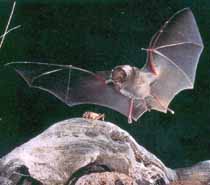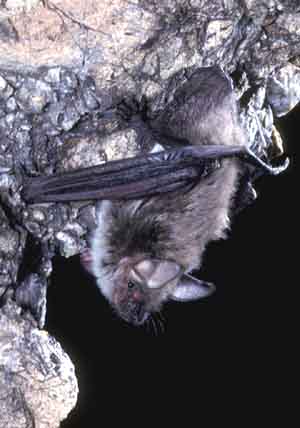
Above: Pallid Bat (Antrozous pallidus), in flight with Katydid (see more details below)
Bats (Chiroptera)
Main sources: Nowak, Ronald, 1991, Walker's Mammals of the world, Fifth Edition (two vols.), Baltimore: Johns Hopkins University Press; Hoffmeister, D. F., 1986, Mammals of Arizona, Tucson: University of Arizona Press; Burt, W. & R. Grossenheider, eds., 1976, A Field Guide to the Mammals, Peterson Field Guides: Houghton Mifflin; Cockrum, E.L., 1960, The Recent Mammals of Arizona: Their Taxonomy and Distribution, Tucson: University of Arizona Press; Tyburec, Janet, "Bats", in Steven Phillips and Patricia Comus, eds., 2000, A Natural History of the Sonoran Desert, pp. 461-72, Arizona-Sonora Desert Museum Press, Tucson; Arizona Department of Game and Fish , n.d., Bats of Arizona (a poster) [thanks to the Redington NRCD for sponsoring a workshop on Bats in April 2005];
In addition, we call particular attention to the website of Bat Conservation International (BCI) (see that link), an organization devoted to research, conservation, and education related to bats and their relationships with humans. BCI generously gave us permission to use the images displayed on this page (all are copyrighted by Merlin D. Tuttle of that organization).
Janet Tyburec (cited above) observes that despite the (typically negative and hostile) stereotypes surrounding them, bats are, worldwide, "efficient predators of nocturnal insects, including numerous costly agricultural pests,and they pollinate the flowers and disperse the seeds of hundreds of ecologically and economically important plants." (pp. 461-2) Bats have flown the nighttime skies for more than 50 million years, and amount to some 1,250 species around the world today (Sarah Keeton, BCI, personal communication). They are highly diverse in size, color, in feeding preferences and methods (including true parasitism as in the so-called "Vampire Bats", thumb-sized fliers who use their razor-sharp teeth to make an incision in the skin of living large mammals, lapping the blood with their tongues [ibid.]), and bats occuy most regions of both earth hemispheres except for the very cold regions (beyond the limits of tree growth) and certain remote oceanic islands. The only mammals that truly fly, their wing membranes are elastic and thin extensions of the skin of the back and belly which extend from tail to neck, supported by the elongated fingers of the forelimbs.
In their distribution maps for Arizona, E.L. Cockrum and Donald Hoffmeister (each cited above) list the California Leaf-nosed Bat (Macrotus californicus), the Mexican Long-tongued Bat (Choeronycteris mexicana), the Long-nosed Bat (Leptonycteris nivalis), the Cave Myotis (Myotis velifer), the California Myotis (Myotis californicus), the Fringed Myotis (Myotis thysanodes), the Long-legged Myotis (Myotis volans), the Western Pipistrelle (Pipistrellus hesperus), the Red Bat (Lasiurus borealis), the Greater Mastiff Bat (Eumops perotis), and some others as recently located in or near our area (the lower San Pedro River Watershed), but which of these kinds of bats may be darkening our particular evening skies these days is not known to us at this time.
However, Janet Tyburec (cited above -- see her essay for details and for drawings of some of the bats) distinguishes four groups of bats ranging the Sonoran Desert:
Ghost-faced Bats
This is a small family of bats having "flaps and folds of flesh around their mouths, often set off by large, obvious hairs or whiskers" (Tyburec, p. 462), fast fliers who may "hawk" (swoop to catch) insects near pond surfaces. Our area is one northern limit of their range (which extends all the way to northern South America, mainly in arid zones where winters are not very cold). They roost in caves etc, are not known to hibernate, and while hunting generally fly high (Tyburec 462-4). We have no images of Ghost-faced Bats at present.
New World Leaf-nosed Bats
Perhaps the most diverse of bat families, some are insectivores or even vertebrate-eaters, others pollinate tropical plants, still others eat fruit. In our area, three species migrate north in the springtime to eat the fruit and nectar of columnar cacti, then go south while eating that of flowering agaves. These include the Long-nosed Bat, and the Mexican Long-tongued Bat (see below for taxonomic names). The third, the California Leaf-nosed Bat, is a uniquely desert-adapted nocturnal hunter who plucks insects from foliage without slowing down, and has been known to survive in a laboratory without water for at least 6 weeks at a time.(Tyburec pp. 464-6)
The Lesser Long-nosed Bat (Leptonycteris curasoae) migrates into our area in the Spring, using its specialized nose and tongue to feed on nectar and pollen of our columnar cacti (at left, on Saguaro fruit) and agaves. It is listed as an Endangered Species by the US Fish and Wildlife Service, and is on the list for Special Concern by ADG&F. Click on images to enlarge.
The Mexican Long-tongued Bat (Choeronycteris curasoae) ranges into our area in the summer, and also frequents the Saguaro-Palo Verde zone where it feeds on nectars and pollens of the large desert plants. Here at right it is shown with Agave pollen on its face.
The California Leaf-nosed Bat occupies our area year-round, where it emerges after sunset, feeds on large night-flying insects for about an hour, then retires until a couple of hours before sunrise, when it forages again (ADG&F). A versatile, agile flyer of medium size (wingspan 340 mm, wieght 12g), it also takes insects and insect larvae from vegetation or on the ground, as at left, where it looms upon a cricket resting on a rock.
Vesper Bats
The largest family of bats, these are mainly insectivores (though some have evolved long feet and sharp claws used to catch fish from ponds), and have plain faces without flaps or folds. They can survive in many habitats, including rather cold regions, by hibernating deep within caves, and have fur coats of diverse colors. They include in our area the Cave Myotis, the Big Brown Bat, the Pallid Bat, the Western Pipistrelle, and several others (see below for taxonomic names). (Tyburec, pp. 467-70)
The Cave Myotis (Myotis velifer) occurs from our area northward to below the Mogollon Rim, a fairly large and grayish bat which emerges before dark and feeds on insects just above the vegetation (ADG&F). At right, you see one perched on rock.
The Big Brown Bat (Eptesicus fuscus) is found from Alaska to South America, often at higher elevations in our area. It flies in long straight patterns searching for insects (ADG&F). See its portrait at left.
The Pallid Bat (Antrozous pallidus) is fairly large, light-colored, and big-eared, found to the northwest as far as British Columbia. We see it here during the summer, where they form strong social groups and take much of their food by stalking on the ground (AGD&F). The one at right holds a Katydid. Pallid Bats are highly vocal. See the banner photo at top of the page for a larger image.
The Western Pipistrelle (Pipistrellus hesperus) is the smallest bat in the United States, with a wingspread of 190-215 mm (around 8") and a weight of 4-6 grams. These butterfly-like fliers feed from well before sunset throughout the night until well after sunrise, and they roost in rocky crevices (ADG&F). The one at left is roosting in a cave.
Free-tailed Bats
Bats of this family have "a thick tail that protrudes freely from the tail membrane for at least 1/3 of its length" and "long, narrow wings and forward-projecting ears" (Tyburec, p. 471), and they are high, fast fliers (up to 60 mph), all insectivores, who may make long annual migrations. Among these, the Mastiff Bat is the largest bat in the United States, with a wingspan of more than 20 inches (Ibid., p. 471-2).
 The Western Mastiff Bat (Eumops perotis) occurs in a number of different areas (including Cuba and South America), but is "included on the Arizona Game and Fish Department's draft list of Wildlife of Special Concern in Arizona" (ADG&F). The largest bat in the United States, its wingspread reaches from 530-570 mm and its weight 60 grams. It emerges in mass groups, forages very high, and the animals are highly and audibly vocal. They roost in cliffs and rock crevices. (ADG&F)
The Western Mastiff Bat (Eumops perotis) occurs in a number of different areas (including Cuba and South America), but is "included on the Arizona Game and Fish Department's draft list of Wildlife of Special Concern in Arizona" (ADG&F). The largest bat in the United States, its wingspread reaches from 530-570 mm and its weight 60 grams. It emerges in mass groups, forages very high, and the animals are highly and audibly vocal. They roost in cliffs and rock crevices. (ADG&F)
Again, thanks to Bat Conservation International (and Merlin Tuttle) for the use of these images. Sometimes it is aptly said that one picture is worth a great many words. These images show us that we are dealing with animals of remarkable beauty, whose value to the world is under-appreciated.
Back to Mammals






